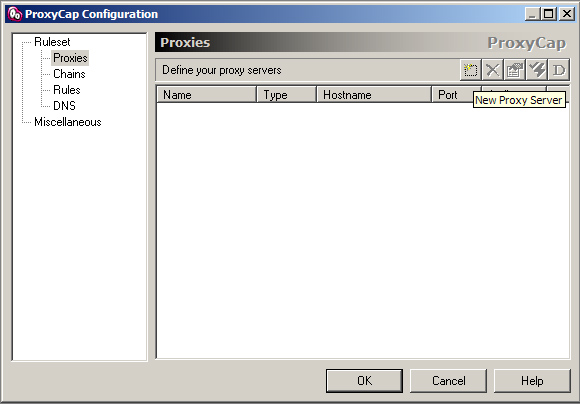


If you want to keep old URLs that point to the old name:2048 working, you can use entries in config.txt similar to this: If you configure EZproxy with a new IP address, you will need to complete the first two steps of this document for the new IP address before you can reconfigure EZproxy to use its new name. See: Add a second IP address to an existing network adapter on Windows. Note: EZproxy is no longer supported on a server also running IIS.
#PROXYCAP HOSTNAME PORT HOW TO#
For more information on how to add a second IP address see Linux or Windows. If you already run a web server on the same server that hosts EZproxy, but you want to use port 80 to alleviate firewall issues, this is possible, although it requires that you assign an additional TCP/IP address to the EZproxy server.

Optional: Running two web servers on port 80 Restart EZproxy for your changes to take effect. In your server, you could use the following to allow the old URLs to continue to function: where EZproxy should listen.įor example, if your old URLs reference port 2048 as the main login port, you may have many old URLs that refer to this port. Other lines can indicate alternate ports. The first appearance defines the "primary location" for logins. LoginPort can appear in config.txt more than once. If you do this, OCLC strongly recommends that you add the RunAs directive statement to your config.txt so that EZproxy does not run as root after startup. If you use "LoginPort 80" on a Linux system, EZproxy must be started as root.
#PROXYCAP HOSTNAME PORT WINDOWS#
If you manage DNS on Windows servers, see Proxy By Hostname Windows DNS Configuration for the steps required to create these entries.

IN A 68.15.177.100īoth of these entries should be made as A records, not CNAME records. If your EZproxy server will run on 68.15.177.100, and if it will operate under the name, then the entries would be: Proxy by host name configuration requires and SSL certificate that is specific to the name of EZproxy.įirst, your DNS administrator must create two entries for your server. This eases resource requirements on your server and simplifies both local and remote firewall configuration issues. The key advantage to the proxy by hostname configuration is that this allows EZproxy to operate on a single port. With proxy by hostname, maps to (the URL generated after a user clicks on the starting point URL ). For more information please review our proxy by port and hostname comparison page.įor example, by default, could be mapped to :2050. This change does not touch existing config.txt files, so any existing sites using proxy by port will be unaffected by this change. For more information, please see migrating to Proxy by Hostname or contact OCLC Support. Proxy by hostname will help ensure seamless access for your library’s e-resource subscriptions. After 30 September 2020, you will need to enable Proxy by Hostname in order to receive support from OCLC. If you are currently running proxy by port, you may continue to do so for the time being. OCLC will end support for EZproxy’s proxy by port option on 30 September 2020, due to its incompatibility with many popular e-resource websites.


 0 kommentar(er)
0 kommentar(er)
